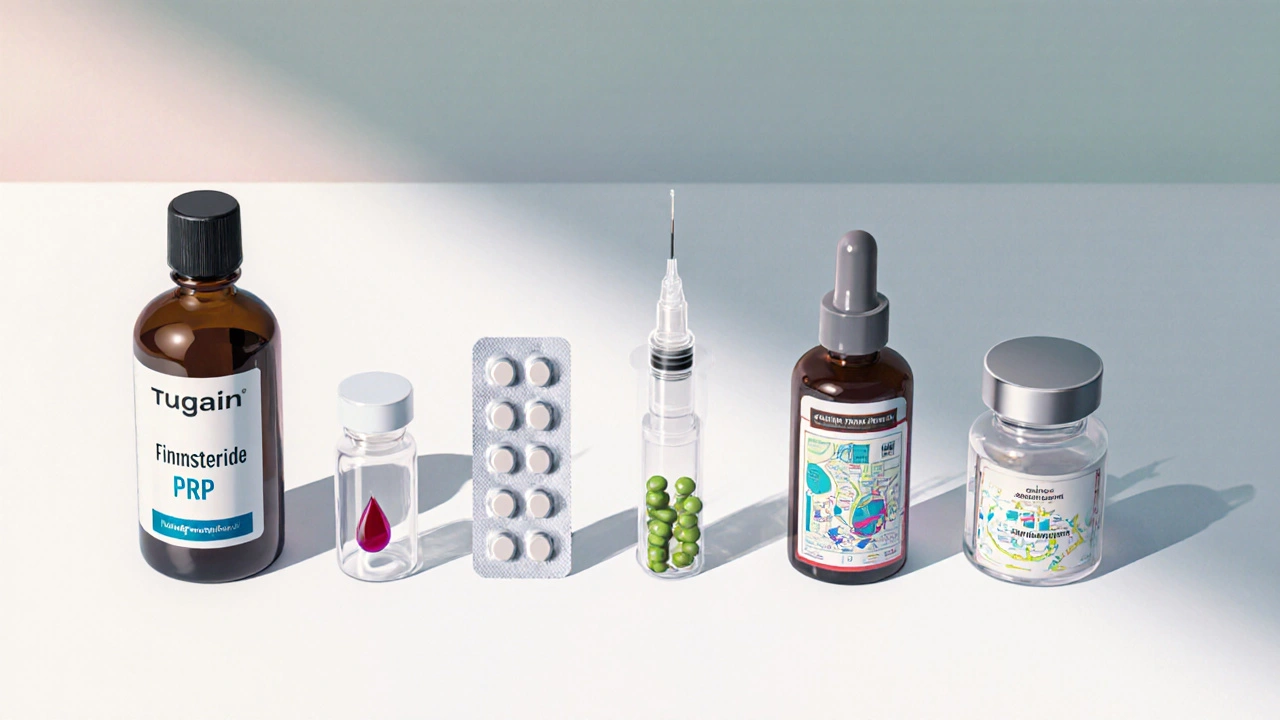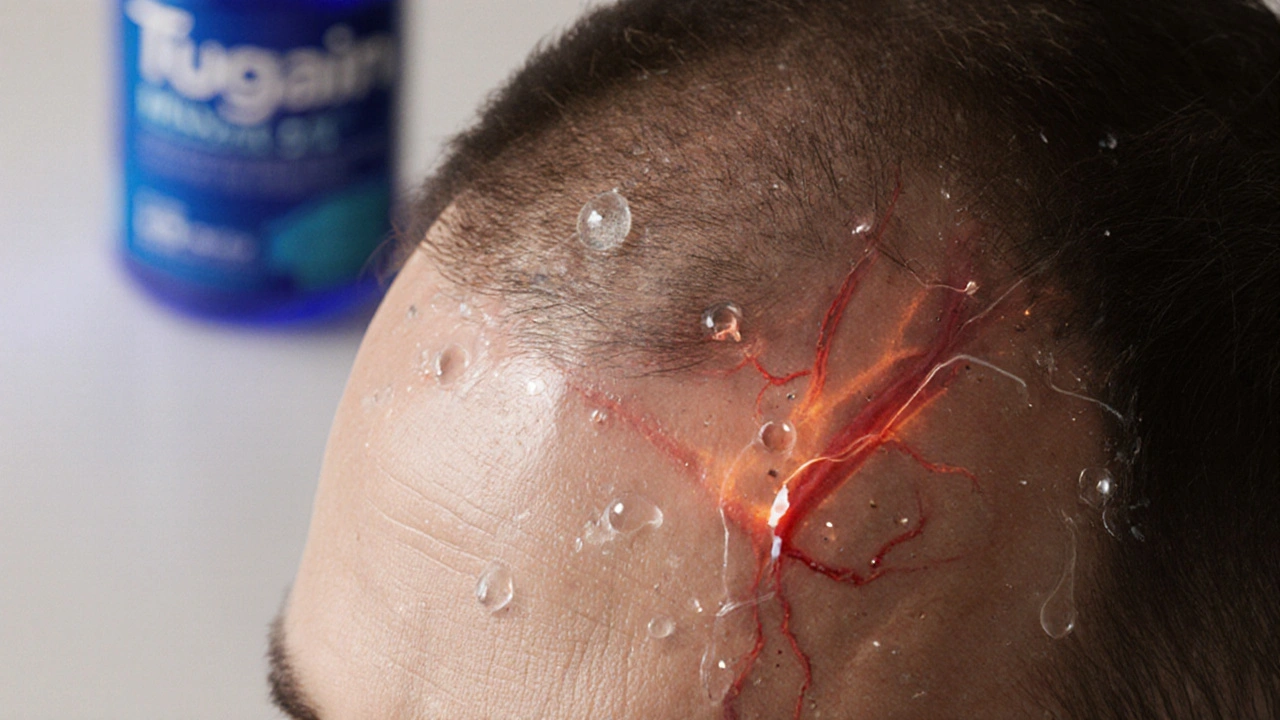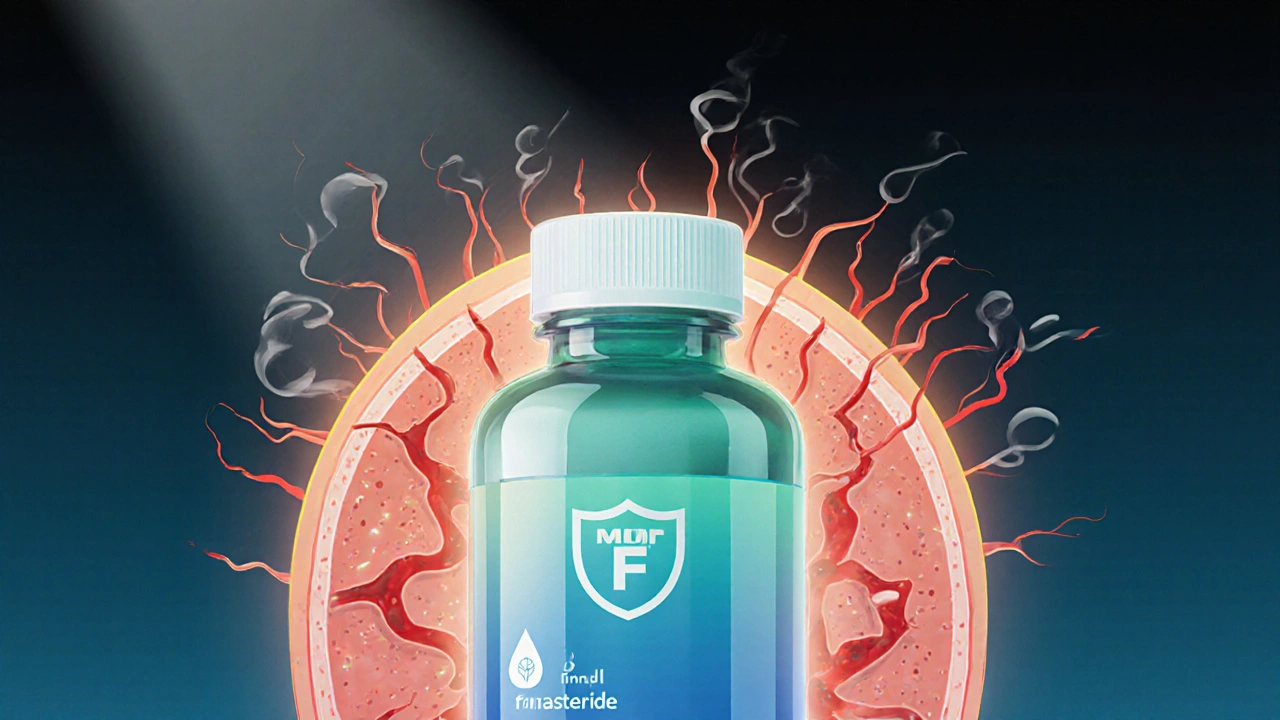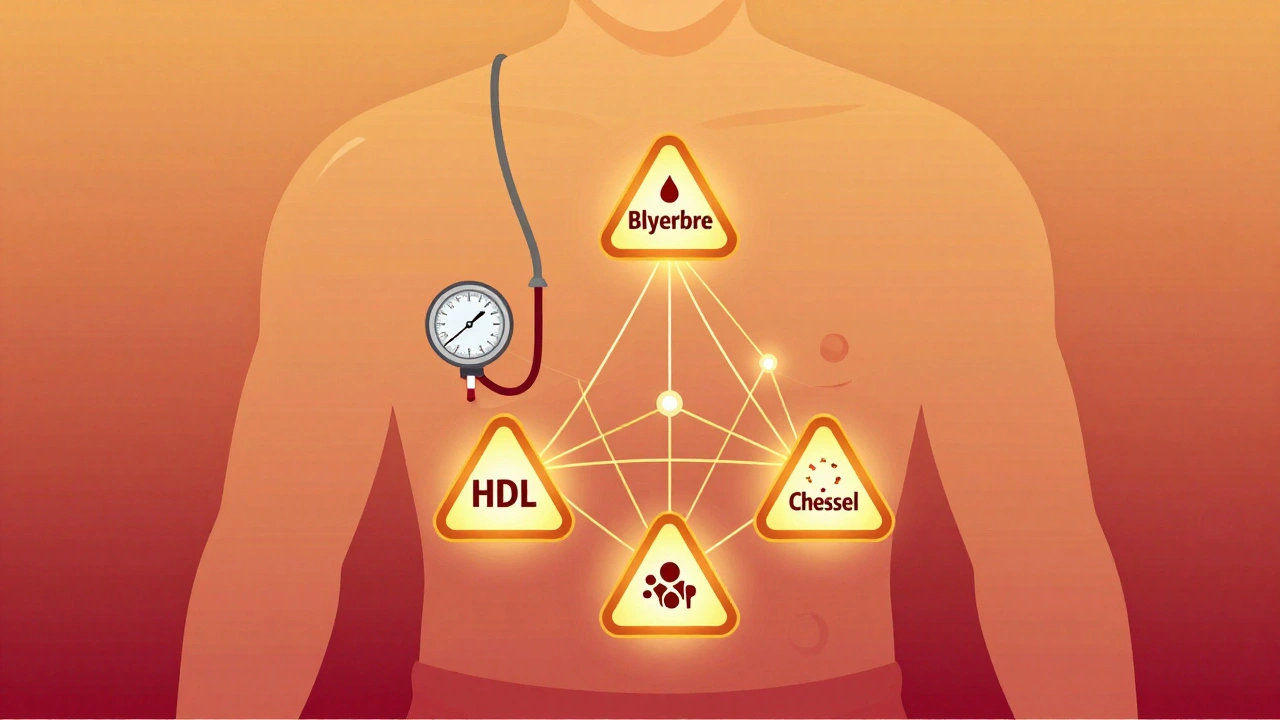When you search for a solution to thinning hair, Tugain is often the first name that pops up. Tugain is a topical formulation that delivers Minoxidil at a 5% concentration, approved for male‑pattern and female‑pattern hair loss. It works by widening blood vessels in the scalp, allowing more nutrients to reach dormant follicles, which can reactivate growth cycles.
Key Takeaways
- Tugain (Minoxidil) offers solid efficacy but can cause scalp irritation for some users.
- Finasteride, PRP, and low‑level laser therapy provide alternative pathways with different side‑effect profiles.
- Cost, application frequency, and long‑term commitment vary widely across options.
- Choosing the right product often means balancing efficacy, safety, and lifestyle fit.
How Minoxidil Works - The Science Behind Tugain
Minoxidil was originally an oral medication for high blood pressure. When applied to the scalp, it acts as a vasodilator, increasing blood flow to the hair follicle. This boost in circulation delivers more oxygen and nutrients, extending the anagen (growth) phase of the hair cycle. Clinical trials show that 5% Minoxidil can increase hair count by 10‑15% after six months of consistent use.
While the exact molecular cascade is still being researched, two mechanisms are widely accepted:
- Opening of potassium channels, which leads to follicle enlargement.
- Up‑regulation of vascular endothelial growth factor (VEGF), promoting new capillary formation around the follicle.
These actions translate into thicker, longer strands for many users, but the benefits plateau after about a year. Continued application is required to maintain results.
Top Alternatives to Minoxidil
Below is a quick look at the most common alternatives that people compare against Tugain.
Rogaine is essentially the same active ingredient (5% Minoxidil) sold under a different brand name. Its pricing and packaging differ, but the efficacy is comparable.
Finasteride is an oral prescription medication that blocks the conversion of testosterone to dihydrotestosterone (DHT), the hormone most linked to follicle miniaturization. It is approved for men only.
Platelet‑Rich Plasma (PRP) therapy involves drawing a small amount of the patient’s blood, concentrating the platelets, and injecting the serum into the scalp. Growth factors released from platelets aim to rejuvenate follicles.
Low‑Level Laser Therapy (LLLT) uses red‑light devices-caps, combs, or hoods-to stimulate cellular activity in the hair bulb. The light penetrates 1‑2mm, increasing ATP production and reducing inflammation.
Saw Palmetto is a plant‑derived supplement that loosely inhibits 5‑alpha‑reductase, similar to Finasteride but with a milder effect. It’s taken orally and marketed as a natural DHT blocker.
Ketoconazole shampoo is an antifungal wash that also reduces scalp inflammation and may lower DHT locally. It’s often used as an adjunct to other treatments.
Hair transplant surgery physically relocates healthy follicles from a donor area (usually the back of the head) to balding zones. It offers a permanent solution but comes with higher upfront cost and recovery time.

Comparison Criteria
When you stack these options side by side, three pillars usually drive the decision: effectiveness, safety/tolerability, and practical considerations (cost, time, and maintenance).
- Effectiveness - Measured by % increase in hair density or patient‑reported satisfaction after 6‑12months.
- Safety - Frequency of side effects, severity, and whether medical supervision is required.
- Practicality - Cost per month, frequency of application or visits, and lifestyle compatibility.
Side‑by‑Side Comparison Table
| Attribute | Tugain (5% Minoxidil) | Finasteride (1mg) | PRP | LLLT Device | Saw Palmetto | Hair Transplant |
|---|---|---|---|---|---|---|
| Mode of Action | Vasodilation, follicle enlargement | DHT inhibition (systemic) | Growth‑factor infusion | Photobiomodulation | Weak DHT inhibition (natural) | Physical relocation of follicles |
| Typical Onset | 3‑6months | 2‑4months | 2‑3months per session | 4‑6months (consistent use) | 4‑6months | Immediate (post‑healing) |
| Average Hair‑Count Gain | 10‑15% | 15‑20% | 20‑30% | 10‑12% | 5‑8% | 30‑50% (permanent) |
| Common Side Effects | Scalp itching, redness, occasional shedding | Decreased libido, erectile dysfunction (rare) | Minor pain, swelling at injection sites | Eye strain (if misused) | Stomach upset (high doses) | Scarring, temporary numbness |
| Prescription Needed? | No (over‑the‑counter) | Yes | Yes (clinic) | No (device purchase) | No (supplement) | Yes (surgical consult) |
| Monthly Cost (AU$) | ≈30‑45 | ≈25‑40 | ≈150‑300 (per session, 3‑4 sessions/year) | ≈50‑120 (device) | ≈20‑35 | ≈4,500‑10,000 (one‑time) |
| Maintenance Required? | Twice‑daily application | Daily oral pill | Periodic clinic visits | 3‑5min daily use | Daily supplement | Lifelong care of grafts |
Which Option Fits Your Lifestyle?
Busy professional with limited time? An LLLT device or daily Finasteride pill may feel less intrusive than twice‑daily Tugain applications. If you’re okay with a simple spray, Tugain stays cheap and easy to stock.
Concerned about systemic side effects? Topical Minoxidil (Tugain) and LLLT avoid hormone‑related risks. Saw Palmetto offers a mild, natural DHT block, but the evidence is less robust.
Looking for a permanent solution? Hair transplant gives the most durable result, yet you must be comfortable with the surgical process and higher cost.
Prefer a clinic‑based approach? PRP provides a middle ground-minimal daily chores, but you’ll need to schedule quarterly appointments.

Practical Tips for Getting the Most Out of Your Choice
- Start with a baseline photo. Document your hairline from multiple angles before any treatment.
- Commit to at least six months. Most products need that time to show measurable change.
- Combine complementary therapies. Many dermatologists recommend Minoxidil + Finasteride for synergistic effect.
- Watch for side effects. If you develop persistent itching or systemic symptoms, pause the treatment and consult a pharmacist.
- Consider cost‑per‑hair‑gained. Divide monthly expense by the percentage increase in density to gauge value.
Frequently Asked Questions
Is Tugain effective for women?
Yes. Clinical data shows 5% Minoxidil improves hair density in women with diffuse thinning, though results are generally modest compared to male‑pattern cases. Women should apply once daily to reduce irritation.
Can I use Minoxidil and Finasteride together?
Combining them is common practice. Minoxidil stimulates growth, while Finasteride blocks DHT. Together they can yield a 20‑30% increase in hair count, but you should monitor for side effects and get a doctor’s approval.
How many sessions of PRP are needed?
Most protocols start with three‑monthly sessions, followed by maintenance every six months. Visible improvement usually appears after the second session.
Are low‑level laser devices safe?
They are FDA‑cleared for hair growth and have a strong safety record. The main precaution is avoiding direct eye exposure; most devices come with protective goggles.
What’s the longest‑lasting result from a hair transplant?
Transplanted follicles are taken from the permanent zone of the scalp, so they usually last a lifetime. Proper post‑op care can extend graft survival beyond 20years.
Next Steps: How to Move Forward
If you’re leaning toward Tugain, start with a 2‑month trial: apply 1ml twice daily, use a gentle shampoo, and track progress with weekly photos. If you experience persistent irritation, switch to the foam formulation or reduce frequency.
For those interested in systemic therapy, book a consultation with a dermatologist to discuss Finasteride dosage and possible blood work.
Want a clinic‑based approach? Research reputable PRP providers in Brisbane, check credentials, and ask about the number of sessions included in the price.
Considering a permanent fix? Schedule a free assessment with a hair‑restoration surgeon to evaluate donor density and realistic expectations.
Whatever path you choose, remember that consistency is the secret sauce. Hair growth is a marathon, not a sprint, and the best results come from a plan you can stick to.








Taylor Yokum
October 11, 2025 AT 23:48Hey folks, if you’re thinking about giving Tug‑in a shot, start slow and watch how your scalp reacts. A couple of drops twice a day is enough; don’t go crazy and dump a whole bottle on your head. Pair it with a gentle shampoo and keep a photo log – those side‑by‑side pics are gold when you want to see real change. Also, staying consistent is key – skipping days will set you back. If irritation shows up, try the foam version or cut back to once daily. Consistency + patience = better odds of keeping those strands.
Albert Lopez
October 22, 2025 AT 23:42The comparison table, while comprehensive, glosses over critical methodological differences. For instance, the efficacy percentages for PRP derive from small, uncontrolled cohorts, unlike the robust randomized trials backing minoxidil. Moreover, the cost analysis fails to account for ancillary expenses such as physician fees for PRP or follow‑up visits post‑transplant. A reader should approach the presented figures with a healthy dose of skepticism, especially when the source citations are not disclosed.
Halle Redick
November 2, 2025 AT 23:35Don’t let the numbers scare you – every hair journey is unique. Even if Tugain feels a bit itchy at first, many people see a noticeable bump in density after a few months. Keep a positive mindset, stay consistent, and celebrate the tiny victories. Your future self will thank you for sticking with it.
Erica Harrington
November 13, 2025 AT 23:28I totally get the overwhelm when you’ve got a spreadsheet of options staring back at you. My advice? Pick the one that fits your daily rhythm. If you’re already taking a pill daily, Finasteride slides right in. If you prefer a hands‑off routine, a low‑level laser cap might be your vibe. Whatever you choose, give it at least six months before judging – hair growth likes to play the long game.
Patricia Mombourquette
November 24, 2025 AT 23:22Tugain works but it’s pricey.
karl lewis
December 5, 2025 AT 23:15Allow me to expound upon the philosophical underpinnings of contemporary trichological interventions, for it is a matter of both empirical rigor and metaphysical consideration. First, the principle of causality mandates that a vasodilator such as minoxidil, when applied topically, must increase perifollicular perfusion; this is a well‑documented physiological response grounded in nitric oxide pathways. Second, the temporal dimension of treatment efficacy requires a minimum latency of three months before any macroscopic change can be observed, a fact corroborated by longitudinal studies. Third, one must assess the cost‑benefit ratio, wherein the monetary outlay for Tugain, approximating AU$30‑45 per month, must be weighed against the projected hair‑count gain of 10‑15 %. Fourth, the safety profile, although generally benign, does present such adverse events as scalp irritation and transient shedding; these phenomena are often misconstrued as treatment failure when, in fact, they represent the telogen‑exogen shift characteristic of initiating follicular remodeling. Fifth, combinatorial therapy, namely the adjunctive use of finasteride, has been shown to augment the anabolic effect on hair follicles by inhibiting dihydrotestosterone, thereby reducing the androgen‑mediated miniaturization process. Sixth, the psychosocial impact of hair loss, while anecdotal, bears measurable effects on self‑esteem and social interaction; thus, any therapeutic regimen must also address the subjective quality‑of‑life outcomes. Seventh, alternative modalities such as platelet‑rich plasma and low‑level laser therapy, though promising, suffer from a paucity of standardized protocols, rendering cross‑study comparison arduous. Eighth, the notion of a “permanent” solution is philosophically untenable, as biological systems inherently evolve, and thus maintenance remains an indispensable component of any regimen. Ninth, the ethical considerations surrounding prescription‑only agents, particularly finasteride, require informed consent due to potential systemic side effects. Tenth, it is incumbent upon the practitioner to individualize treatment plans, recognizing that hair biology varies with genetics, age, and environmental factors. Eleventh, patient adherence, often the Achilles’ heel of therapeutic success, can be bolstered by simplifying dosing schedules – for instance, employing the foam formulation of minoxidil which reduces application time. Twelfth, the interplay between scalp microbiome health and hair growth is an emerging field, suggesting that adjunctive antifungal shampoos may confer ancillary benefits. Thirteenth, one must not disregard the financial barriers that may preclude patients from accessing high‑end interventions such as hair transplantation, which, despite its durability, imposes a substantial upfront cost. Fourteenth, the future of hair restoration may well lie in regenerative medicine, where stem‑cell‑based therapies could supplant current treatments. Fifteenth, in conclusion, the clinician and patient must engage in a dialectic, balancing empirical evidence with individual preferences, to arrive at a sustainable, effective hair‑loss strategy. 😊